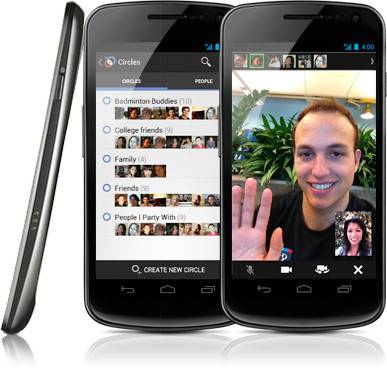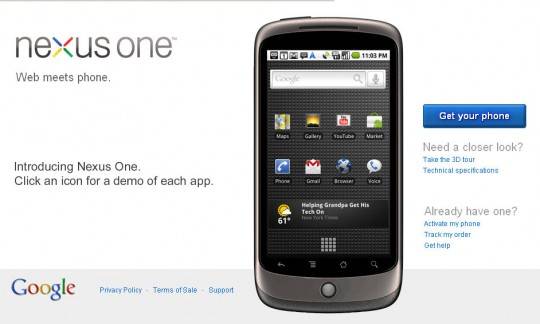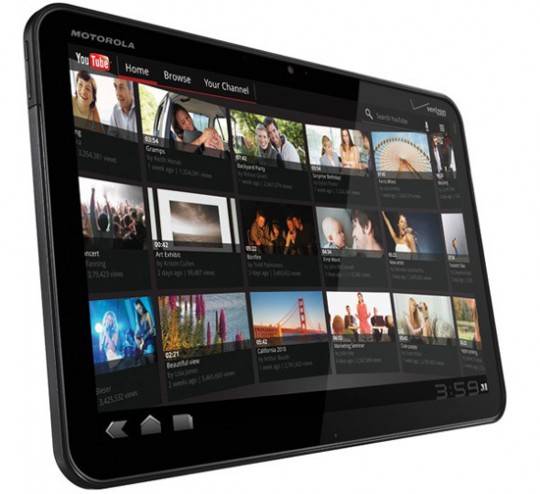
If Verizon’s ridiculous handling of the Galaxy Nexus US launch has taught us anything, it’s that the carriers are still firmly in control of the mobile world, at least in the United States. While there’s no confirmation, strong evidence indicates that Verizon’s desire for a carrier-controlled NFC payment system, which isn’t even anywhere near launching, caused weeks and weeks of delays. Consumers in Google’s own country stewed while seemingly everyone else in the world got a hold of the very first Android 4.0 hardware. All we could do was cry foul until the release, something that a few of Google’s top brass must have been doing as well.
Add that to the Verizon’s continuous stance on locked bootloaders for flagship phones like the DROID RAZR and various carriers booting out apps form the Android Market seemingly at will, and the world’s most widely-used “open” mobile platform is looking more and more like a vector for wireless providers to hawk their secondary and tertiary services to customers without any real options.
So here’s my humble suggestion for fixing this glaring black eye on the Android ecosystem: cut out the middle man, create a set of standards and start selling devices to customers instead of corporations.
The Problem
As Android has exploded in market share over the last year and a half, so too have the frustrating modifications and restrictions that wireless carriers (and, to be fair, phone manufacturers) have placed on devices that are “owned” by their customers. The excitement over the Galaxy Nexus wasn’t just for Ice Cream Sandwich, or even for high-end hardware – after a few contract cycles of locked-down phones, mostly worthless UI additions and absolutely ridiculous wait times for over-the-air software upgrades, even mainstream consumers are beginning to see the value in a phone that’s controlled by Google, not the carriers. Thanks to Verizon’s heavy-handed influence on the Galaxy Nexus, as seen in a pair of bloatware apps and the absence of Google Wallet, the pure Android experience associated with the previous two phones is being severely tainted.

Google, here’s a sentiment straight from the end-users to you: one Nexus phone a year is not enough. Neither is one form factor, because not everyone wants a slate phone with a gigantic screen and no keyboard. If you want to continue to market Android as the future of mobile computing, you need to take back some of the control you wielded in 2008 and 2009. Begin demanding that carriers and manufacturers make “clean” Android available to consumers, free of any carrier or manufacturer additions.
And if they won’t do it, then Google, you need to.
The Program
The Nexus models are the most sought after phones by die-hard Android users, not because they’ve got the best hardware or the most features, but because we know they’ll always have the latest and greatest Android software. So why stop at one phone a year? Android is now mature enough that home developers can build a working OS from source on generic hardware in a single day. There’s nothing stopping manufacturers from putting a clean version of Ice Cream Sandwich on any hardware released in the last three months. And if the bile-filled messages aimed at Verizon on Twitter and Facebook from the last few weeks are any indiction, that’s what an increasing number of people want.

So give it to them. Instead of working with one company for months and creating a standard model, let any manufacturer submit any hardware for the Nexus label. Stipulate that they deliver hardware that runs the latest version of Android, free of any bloatware or modifications, and open for anything that users want to do (including custom ROMs and even other operating systems). Then let them use the Nexus name and send out the software updates from Google HQ. Yes, it’ll take more manpower, but it’s not like Google has any sort of cash problem… and keeping Android users happy with the platform is worth the investment.
And here’s the kicker: start selling Nexus hardware from Google again. The original Nexus One was sold directly from Google, and while it wasn’t any kind of a smash hit, the market is ripe for a top-down experience now. Verizon is even using SIM cards at this point, and a stipulation of the Block C spectrum purchase says they have to let customers use their own FCC-compliant hardware if they want. Google, please, sell us phones and tablets directly, and I guarantee there will be an uproarious response from users. We’re tired of seeing the latest and greatest devices come out only to have some crippling software bug from meddling manufacturers and carriers, then waiting months for half-hearted fix.
As Nexus phones start to become the gold standard for all Android users, from the technorati obsessed with a ginormous Super AMOLED screen to the soccer mom who only wants a quick and easy way to run apps, carriers would have to play ball in the Nexus court. After that you can start selling Nexus phones and tablets with contracts and discounts, like any retailer.

The Process
Phones and tablets submitted to the “Nexus Certified” program would need to meet three basic guidelines. One, absolutely nothing but Android’s latest core software, plus Google’s branded suite of apps. No manufacture UIs, no features disabled, no carrier crapware. Yes, that includes an account manager, and nothing can be off-limits – I’m looking at you, Google Wallet. Two, all Nexus phones and tablets have to be completely open to the user. That doesn’t mean they come rooted or unlocked, but no effort to block advanced users from installing modified software should be present. That includes locked bootloaders. Advanced users, this carries some responsibility for you as well; kiss your warranty goodbye the moment you root. Mods and custom ROMs come with risks that the manufacturer/carrier shouldn’t have to bear. Three, all Nexus devices must be offered free of the carrier sales channel. Carriers could also sell the phones using the standard subsidy model, but if it’s only available for purchase through a carrier, it’s not a Nexus phone.
Even if Google doesn’t get any takers – a real possibility, as even minor league manufacturers like LG seem intent on souring Android with changes purely for the sake of differentiation – they’ve got an ace in the hole. Google just happens to have a brand new hardware subsidiary in Motorola Mobility, and it’d be a real disservice if every Motorola device made after the acquisition didn’t run pure Android. (If you just really love MotoBlur, or whatever they’re calling it this week, feel free to prove me wrong in the comments.) The original XOOM tablet was a good start, now make pure, updated Android the standard for the entire company.

Google wants to make phones and tablets that rock. The original carrier-free Nexus One, the WiFi tethering feature in Android 2.2 (always either dropped or bogarted for an extra fee by carriers), and the app disabling features in Ice Cream Sandwich prove that. And Google, we want to use them, but all too often we’re stymied by a group of companies that are so entrenched and focused, customer experience is absolutely the last thing on their minds.
Building out a new wireless system in the US, one that actually encourages openness and user freedom, is practically impossible… at least for the moment. So don’t. Just do what you do best in the mobile space: make great software that works with everything. Then reward manufacturers, and eventually even carriers, who do the right thing by giving them the most desirable label in the Android world. Give us Nexus devices that are as diverse as Android is now, in features, form factor and price, and you’ll see people flock to use Android like it’s meant to be used.










Okay, Here’s a few ideas that I would put out in the mix.
First problem I see is that the updates come from google right? Which means that google needs to have all hardware driver stuff for when a new update comes along. So when samsung makes a devices with a tegra 2 chip, samsung can’t do anything about the lag of the chips driver. That’s in Nvidia’s ballpark for the most part unless they have some sort of deal.
The other problem that I see with this is that manufactures won’t want to do this if they can’t add their own UI stuff to add a little differentiation.
So requirements to get into the Nexus Program I could see as:
1. Google has access to all the stuff of that phone at the same time the manufacturer of the phone has access to it.
2. Updates come directly through google through a program that will update the device, which just skips the carriers all together.
3. Manufactures can upload UI changes (touchwiz, sense, etc) but they have to be compatible with the latest version of android out, they can only be used on a device made by them, and there has to be an option to have the UI AND to be able to revert back to stock.
4. Android licensees out access to the market, right? For phones that are granted access to the Nexus phone, the price is Free or reduced.
The problem though still rests upon third party drivers. How do we give them incentives to release the drivers ASAP. Nvidia is getting popular on android devices, but manufactures that wan’t to be in the nexus program can want that but no good will come if those that make the drivers aren’t on board. It is a problem, but some solution needs to come about.
I wouldn’t have said this before ICS, but: hear hear.
Absolutely agree 100% after seeing ics there is no need for costume ui’s anymore. I say do away with that and stick with the new look from now on for all future android phones, look at the Iphone for example it’s on three different carriers but yet no costume ui or anything tainting it. It’s possible guys!
Why they don’t do a OS that can be installed in every phone?
I don’t need DELL or HP to update my windows 7.
Why Google don’t develop a OS that can be install in generics hardwares, like windows do in PCs?
Simple, manufactures don’t have much control. They are limited to what they can do with their devices. They all have to have the same buttons, the same processors, the same data connections (wp7 doesn’t support wimax or lte) the same screen resolution and so on.
If Android had such limited hardware variation it would be much easier to accomplish.
I definitely think this article is on the right track. As said by someone below, Windows on any PC/laptop comes from Microsoft, and so do the updates. We don’t have to ask HP, Dell, Acer, Asus, etc. for Windows upgrades. Intel and AMD make compatible processors, and Microsoft has a driver repository and a certification program for third party device manufacturers. Apple has tight control over iPads and iPhones, so why can’t Google have more control over the release and update process for Android phones? Mobile hardware manufacturers and service carriers only slow things down, add junk, and create problems.
Google, what’s the problem? Android fragmentation, manufacturer and carrier bloatware is your fault. Fix it.
Microsoft releases an OS every what, 4-5 years? And a lot of the older hardware isn’t supported by newer versions of windows because they don’t want to keep the drivers up to date. When vista first came out it was a disaster because it had to have all new drivers made for the OS and a bunch of things didn’t work. I think Google should have some sort of nexus program, but the real problem that they would face then is with manufactures of hardware that don’t want to push out drivers or don’t do so in a timely manner.
Great article with nice ideas in it which I really enjoyed reading. Keep up the good work!
You can’t just certify phones as Nexus. The operating system was built around specific Nexus reference designs and when you buy a Nexus phone, it’s the specific phone that Google wrote the operating system on. It’s a developer phone sold to the general public. It is not possible for another phone to get the operating system before that phone, because they write it on that phone specifically.
They already have a certification program. It’s called Google experience phones.
No, no, no, no. You miss the entire point of having a single Nexus phone per release cycle. They are *the* reference phones for others to follow. There is a deliberate reason, aside from monetary ones, that iPhones are released once every 1-2 years: to make each one better than the one before it. What you are proposing is nothing more than slapping the Nexus name on a glut of phones created by anyone, i.e. the exact same thing going on now with non-Nexus phones. We can get 50 mediocre Nexus phones indistinguishable from each other (and the rest of the market) or we can get 1 great phone and Google has taken the latter path, the same one taken by Apple.
The Nexus phones are not created to be a delivery mechanism for the latest version of the OS, they are created to deliver a singular experience of exactly what Google wants from hardware to software, soup-to-nuts. What you suggest is a dilution of that ‘pure’ experience whereby it would no longer be pure in any fashion. Why would anyone want to buy a single Nexus S or Galaxy Prime model when they can buy any combination of a Nexus EPIC 4G+ LTE with Super AMOLED Unicorn? It simply dilutes the brand entirely.
Phones are not the issue, distribution is and now that Android has seriously taken off and this screw-up with Verizon will prove to Google one thing: release the phones themselves (or through all carriers at once) or work with one carrier because it brings them boatloads of money (à la Apple).
I don’t see what would stop multiple Nexus phones running the same operating system with consistency. CyanogenMod manages timely updates across dozens of devices, making slight changes for each according to their features. Even Google has to work separately on the Nexus One, Nexus S, Galaxy Nexus and XOOM. Why not expand the operating to put more “clean” Android devices in the hand of consumers?
To be fair, I am NOT a developer, and I don’t have the same priorities as they do. I speak as an informed end-user, that’s all.
I think they should simply build a mechanism for updating all the phones at once similar to the way Windows Phone 7 works and Windows update on your computer works.
Building some gigantic program to mimic the effects of actually selling your reference device across many devices may sound good, but it would slow down android development and just make things worse.
Google Experience was meant to be what you’re talking about, but few devices actually are Google Experience phones. The market isn’t selecting that for some reason.
“I don’t see what would stop multiple Nexus phones running the same operating system with consistency”
This is because you don’t understand what the Nexus phones are and represent despite my rather lengthy explanation of it, Aaaron Burke’s own expansion of mine, and Google’s *own* explanations of it. You don’t understand it because you look at the issue solely as one based on “I want more phones and I want them now”. Either you didn’t read any of this or have a real inability to understand what Google is doing with the Nexus line.
This is not just an issue of software development, so bringing up how CyanogenMod maintains so many versions is irrelevant. The Nexus phones and Android itself are developed directly in tandem to put forth the best features of both at the same time when the phone is released.
Apple has proven since 2007 that making a single phone per cycle works much better than cranking out dozens of them every time.
Agreed! I want to add to your point of the Nexus line:
1) They are *reference* devices.
The hardware and software are developed in tandem (presumably).
2) They are *developer* devices.
Let the user download the custom UIs, if they want one, but don’t force them on us.
The one flaw in your theory: The carrier may not offer the discounted price for a 2 year contract. Therefore, the certified phones would be at full price > $500. If only the carriers offered a discount for the usage for phones off contract. That might make the pricing more attractive for certified phones.
I said that carriers could offer the phone (subsidized, discounted and on-contract) but that it couldn’t be the only way to get it. The fact that I HAVE to go to Verizon or one of its retail partners for the Gnex really bothers me – it’s one more buffer between me and the operating system.
@jwestfall:disqus —-Hear this……My best friend’s mom makes $ 69 an hour on the computer. She has been out of job for 11 months but last month her check was $ 6623 just working on the computer for a few hours..Read about it here.....http://www.BestJob….
Yes, yes and yes! While I was waiting for the iPhone to be updated, my dumbphone died and I sort of fell into the Android eco-system without knowing much about it. Over the past few months, I have learned quite a bit, and this article seems to go with most of my thoughts. I believe that a stock android experience should be available upon update. The crapware that carriers have and custom UI’s that OEM’s offer should absolutely be OPTIONAL. I think it was nuts that my phone was running Froyo a year after GB had been released, and ICS was even released before it finally got a GB update OTA. Was so annoyed by this fact that I finally rooted my phone and flashed an experimental ICS, which is absolutely gorgeous and operates SO much more smoothly. ICS is much more on par with my experience on IOS on my iPad than the experiences I had with Froyo and then Gingerbread, both of which I hated for how laggy they were in comparison. Hadn’t thought of multiple Nexus devices, but it seems like an idea with some merit that could be explored. If I had to it all over again, I would have purchased a Nexus device as because, as you mentioned, they get stock updates ASAP and generally with little interference from the carriers.
This is why I’m hopeful that Google’s acquisition of Motorola goes through. All phones and tabs from Moto will be pure Nexus style sets. Manufacturers and carriers will have to change their ways in order to compete with Moto.
I think this is exactly why Google bought Motorola. Instead of angering the manufacturers, I hope it sets the stanadard. The only thing missing in this article is getting the other phone manufacturers on board. Let VZW and ATT stand up to Google, HTC, Samsung, and LG and see how far it gets them. They don’t stand a chance.
Carriers are in firm control and will be, that’s just the way the US cell markets work. Google tried selling this direct, and you saw the response. No one wants to pay $500 for a phone. Everybody wants to pay $100 at the most. Until Google is able to figure out a way to offer contract discounts, I think they have given up on this idea. While I agree with your sentiment, I don’t see things changing for the sake of the consumer.
The US just doesn’t work that way. You think that if there was (or is?) a cure for cancer or diabetes that it would be available? No way, they make too much $$ in treatment. Releasing something like that would take down an entire ecosystem. It’s all relative in concept…
As a Canadian, dealing with worse carrier situations then you guys in the states are, I just want to say that consumers are ready for out right purchasing of phones but there are problems. First, consumers really do know the many ways they are getting gang raped by the system. People aren’t that dumb, in general. Secondly, even if I buy a phone outright to avoid some of these pit falls the carriers still charge my like I have subsidized the phone through them, so they just make MORE money at my expense. Until this changes, buying phones outright doesn’t make a lot of sense, even to all the consumers like myself that understand the many gory ways we are being ripped off.
OK, not “at most”, but the price point is well below the $400 to $500 for a phone without a contract. If the carriers would just leave the hardware locks out of the equipment, it would be nice. We should be able to easily root our devices to put our own ROM’s, root apps, etc on our OWN PHONES. I absolutely hate the crapware that gets loaded on the stock O/S, and in fact there have been a couple of handsets that are compromised right out of the box because of said crapware apps. It’s too bad that the US has the mentality that it has chosen. It’s corrupt.
Not only should the Nexus line have a “certification” program as you suggested, but a hardware requirement for running the newest Android OS should be openly published so that phone manufacturer’s and carrier’s cannot get out of upgrading phones to the newest OS (that’s you Samsung for screwing us Galaxy S owners with a seriously delayed Gingerbread and non-existent ICS upgrade). See: http://androinica.com/2011/12/samsung-ice-cream-sandwich-update/
I know that I could get a ROM cooked and put on my phone (which I have) but an “official driver-included” update is always nice and allows for greater, various ROM customizations.
A hardware requirement list would give end users the informed ability to (rightfully) put pressure on manufacturers and carriers to continue to support older devices. And by older, I mean devices that are a whole 18 months old!When you go buy software for your PC or Mac or Linux box, there are documented requirements to make said software run (some even have “preferred requirements” to get the best experience out of the software). Why is there no such mechanism in place for the Android OS? Or if there is, where can I find it?
Just as a point of clarification:
Did you intend ‘Nexus certified” devices to be sold by the manufacturer or google?
If you meant Google should vend them, there are obvious issues with that. But if google just stamps them and the manufacturers vend, then that’s pretty legit. Anything to take the hardware away from the vendors, which have clearly been abusing the shit out of their power for the last decade.
Biggest problem: hardware manufacturers make *very* little profit on Nexus phones. The incentive they have to create Nexus phones in the first place is free advertising and promotion by Google; they sit in the spotlight. If there are several Nexus phones at the same time, that advantage will be lost, and hardware manufacturers will have no incentive to participate in the tiny-profit program.
Most people don’t want to pay $500-$600 for a phone, and most carriers give you no discount on monthly service when you pay full price for your phone. Nexus must remain exclusive and one main spotlight device at a time.